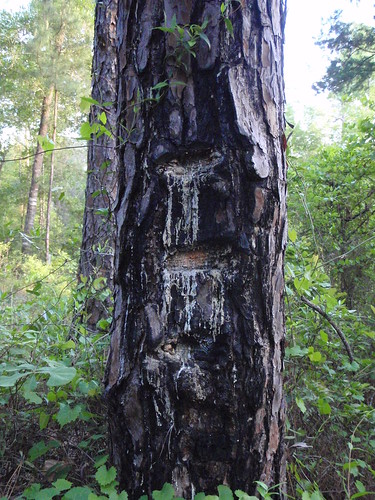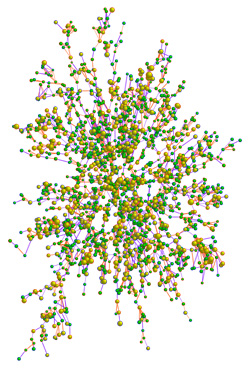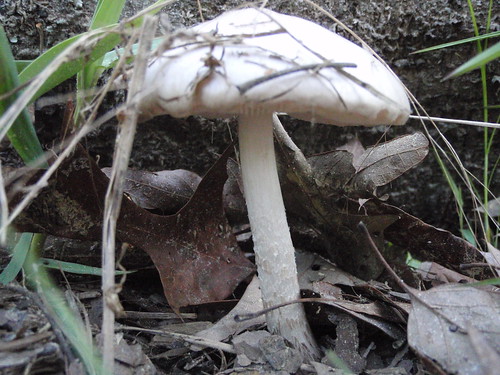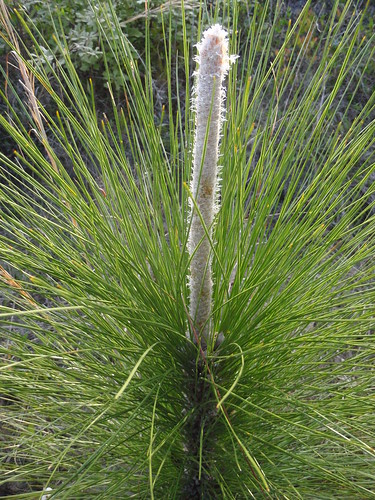Some smilax and grape vines: Continue reading
Author Archives: John S. Quarterman
Obesity Network
The two men started publishing their findings with a splash: a 2007 article in the New England Journal of Medicine reporting that obesity spreads through social networks, as people are apparently influenced by friends’ weight gain to become obese themselves. More perplexing is their finding that obesity spreads through up to three degrees of separation. If a subject named a friend who was also in the study, and that friend’s friend became obese, the first subject’s chances of becoming obese were roughly 20 percent greater. Across one more degree of influence (husband’s friend’s friend or friend’s sibling’s friend—i.e., three degrees away), the risk was 10 percent greater. Weight gain appears to ripple through friend groups via some unseen mechanism such as altered eating or exercise behavior, or adjustment of social norms regarding weight.We are our brother’s keeper, and our brothers, sisters, aunts, uncles, parents, children, friends, colleagues, and neighbors are our keepers.The authors found similar patterns for happiness, loneliness, depression, alcohol consumption, the decision to stop smoking, and even divorce. “Our health depends on more than our own biology or even our own choices and actions,” they write in Connected. “Our health also depends quite literally on the biology, choices, and actions of those around us.”
In the spring piney woods
Cancer in the Air, Food, and Water
 Lyndsey Layton
writes in the Washington Post that:
Lyndsey Layton
writes in the Washington Post that:
An expert panel that advises the president on cancer said Thursday that Americans are facing “grievous harm” from chemicals in the air, food and water that have largely gone unregulated and ignored.Somebody noticed!
The President’s Cancer Panel called for a new national strategy that focuses on such threats in the environment and workplaces.The problem is not too many agencies. Here’s the problem: Continue readingEpidemiologists have long maintained that tobacco use, diet and other factors are responsible for most cancers, and that chemicals and pollutants cause only a small portion — perhaps 5 percent.
The presidential panel said that figure has been “grossly underestimated” but it did not provide a new estimate.
“With the growing body of evidence linking environmental exposures to cancer, the public is becoming increasingly aware of the unacceptable burden of cancer resulting from environmental and occupational exposures that could have been prevented through appropriate national action,” the panel wrote in a report released Thursday.
Federal chemical laws are weak, funding for research and enforcement is inadequate, and regulatory responsibilities are split among too many agencies, the panel found.
Candling Longleaf
This nine foot loblolly is about 3 years old, as you can see since John S. Quarterman can reach 8 feet high and it’s a foot higher than that: Continue reading
HFCS downfall?
 Let’s hope Melanie Warner, writing in bnet, is right about
The Death of High Fructose Corn Syrup:
Let’s hope Melanie Warner, writing in bnet, is right about
The Death of High Fructose Corn Syrup:
The back-to-back, double whammy announcements that PepsiCo (PEP) is ditching high fructose corn syrup in Gatorade along with the results of a scathing new study from researchers at Princeton make it official — allies of the controversial sweetener have lost the war.
What the Princeton researchers found was
A sweet problem: Princeton researchers find that high-fructose corn syrup prompts considerably more weight gain,
as we noted here a while back.
And, as we noted last year, there’s also
an eerie correlation of the spread of
HFCS into the food supply with the rise of obesity in the U.S.

Here’s Melanie Warner again, this time in the New York Times:
Hunt’s ketchup is among the latest in a string of major-brand products that have replaced the vilified sweetener. Gatorade, several Kraft salad dressings, Wheat Thins, Ocean Spray cranberry juice, Pepsi Throwback, Mountain Dew Throwback and the baked goods at Starbucks, to name a few, are all now made with regular sugar.
Why is Big Food buckling about bogus sugar?
What started as a narrow movement by proponents of natural and organic foods has morphed into a swell of mainstream opposition, thanks in large part to tools of modern activism like Facebook, YouTube and Twitter and movies like “Food, Inc.” and “King Corn.”Well, well. Voting at supermarket checkout seems to be working after all!
Windowfall
Rain pouring through window, Nashville, Tennessee, 2 May 2010.
Meanwhile, upmoat: Continue reading
Elsie Quarterman Glade Festival
 Some of you may remember my aunt, Elsie Quarterman, born in Valdosta,
played basketball for Hahira High School:
Some of you may remember my aunt, Elsie Quarterman, born in Valdosta,
played basketball for Hahira High School:
At 99 years old she won’t be outwalking everybody like she used to, but she will be there. Road trip to Lebanon, Tennessee? Y’all come!Cedars of Lebanon State Park will host its annual Elsie Quarterman Cedar Glade Wildflower Festival April 30 – May 1. Held in partnership with The Center for Cedar Glade Studies of Middle Tennessee State University, this event will offer visitors an opportunity to learn more about the area through seminars, guided nature walks, exhibits, guest speakers and naturalist displays. All events are free and open to the public.
“We are honored to be hosting this 33rd annual event and excited about the roster of experts on hand during this two-day festival,” said Park Ranger and Naturalist Wayne Ingram. “We have numerous activities and educational opportunities planned for all ages and encourage everyone to join us – rain or shine.”
Dr. Elsie Quarterman was professor Emeritus of Vanderbilt University and pioneered cedar glade research in the early 1950s. Coupled with her extensive research at this site, Dr. Quarterman has been an advocate for natural area protection throughout her distinguished career. Her efforts helped Tennessee in 1971 become one of the first states to pass legislation to protect natural areas in the U.S.
Echinacea tennesseensis, the Tennessee coneflower, thought to be extinct until Elsie rediscovered it: Continue reading
Hamster Roundup: sterility and infant mortality

|
“This study was just routine,” said Russian biologist Alexey V. Surov, in what could end up as the understatement of this century. Surov and his colleagues set out to discover if Monsanto’s genetically modified (GM) soy, grown on 91% of US soybean fields, leads to problems in growth or reproduction. What he discovered may uproot a multi-billion dollar industry.Not just a little higher: five times highher infant mortality.After feeding hamsters for two years over three generations, those on the GM diet, and especially the group on the maximum GM soy diet, showed devastating results. By the third generation, most GM soy-fed hamsters lost the ability to have babies. They also suffered slower growth, and a high mortality rate among the pups.
And it’s not necessarily the soybeans themselves: Continue reading
Ladybug: Natural pest control
Here’s a movie: Continue reading






